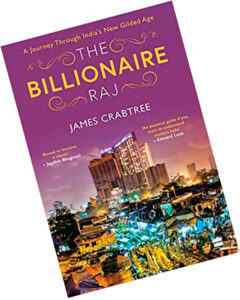Money money money, it’s so funny The world of India’s gilded age and the spawning of newbie billionaires.
It was the docu-series Bad Boy Billionaires that finally pushed me to read The Billionaire Raj by James Crabtree, published by Tim Duggan Books. This beautifully bound item featuring on its dust jacket the Ambanis’s home Antilia reaching disjointedly up into a purple sky had landed on my shelves almost two years ago, courtesy my son. However, despite his constant prodding, I had not got down to reading it, although that had always been on my cards. Perhaps the fact that the makers of the docu-series occasionally called upon Crabtree to share his views on this or that matter finally tipped the balance.
Whatever the reason, I now find myself unable to dislodge my nose from the pages of this curious, complex story communicated in clear, engaging prose. Innumerable voices share innumerable experiences: some come as a bolt from the blue for the average reader, others jog the recall button and the memories come flooding back. And as you read you get a sense of the socio-political, socio-economic and eco-political implications of making more than ‘just a living’ in a country with potential for corruption.
The series that’s airing focuses on three dubious stars of corporate mega-compromise: Vijay Mallya, Nirav Modi and Subroto Roy. The book goes far further, examining the business of business at the topmost echelons, the number of billionaires who have emerged on the Indian scene thanks in large part to their willingness to mix risk with savvy, and not afraid of wheeling-dealing. While the docu-series left me feeling indignant, the book stirs up questions on both sides of the coin as it even-handedly draws an enormous picture that demands your attention.
There’s a context to the description that follows the title: A Journey through India’s New Gilded Age. The term ‘gilded age’ is taken from a reference to the period between the end of the Civil War in 1865 to the turn of the twentieth century — in the United States. Crabtree quotes a historian as saying it was the era of ‘the great corporation, the crass plutocrat [and] the calculating political boss’. A nation that had all along seen itself as ‘a rural, egalitarian idyll: a nation of yeoman farmers governed by gentlemen politicians’ was transformed ‘into a giant continental economy and the world’s leading industrial power’. This ‘growth gave birth to a new generation of plutocrats’, people who grew their businesses and their wealth at an impossibly fast pace and were not averse to vulgar displays of that wealth. For this they earned the sobriquet ‘robber barons’.
The phrase ‘gilded age’ is apparently from American writer Mark Twain, ‘describing a period that glittered on the surface, as if painted in gold, but was decaying underneath. That decay was to be found in politics above all, as the expansion of the franchise in the early 1800s gave birth to the rampant corruption of the “spoils” system. Powerful urban political machines traded bribery and patronage for jobs and votes’. Crabtree goes on to write that he thought India might be going through something similar after reading an article in the Financial Times by venture capitalist Jayant Sinha and academic Ashutosh Varshney. ‘In its rot and heady dynamism, India is beginning to resemble America’s Gilded Age,’ they argued in the article headlined, ‘It is time for India to rein in its robber barons’.
Crabtree does an organised, thorough job, talking about the rise of such industrialists in the first chapter entitled, interestingly, ‘Robber Barons’. They were, undoubtedly, inspired and daring; equally undoubtedly they paved the way for others on the road to super-wealth, particularly in a climate of economic liberalisation. However, as India’s most celebrated intellectual, the economist Amartya Sen, comments, while ‘economic reopening had indeed created a more vibrant economy, [it was] one that was less equal and fair’. Crabtree reminds us that ‘Sen also looked to the successful “tiger” economies of east Asia, but mostly because of the way that they grew rich by investing heavily in basic health and education, which in turn helped to provide social support to poorer workers as they moved from farms to factories and onwards into the middle class. Modern India, by contrast, more often looked like an economy in Latin America, with a weak social safety net and yawning inequality.’
Then the book goes on to discuss the Narendra Modi effect, the series of scams that upturned the economic climate, the collusion of money, power and politics and the special brand of cronyism practiced in South India, with special mention of J Jayalalithaa and Tamil Nadu. The book then winds down with a section entitled ‘A New Gilded Age’. Here Crabtree discusses the ‘House of Debt’ companies; it’s a fascinating account of how stock analyst Ashish Gupta sniffed out the fact that many big industrial houses were caving under mountains of debt. His research led to a 35-page document, ‘House of Debt’, that laid bare the financial mess that followed some years of investment boom. Crabtree writes, ‘Beginning in the early 2000s, many of the country’s major tycoons had gone on a serious borrowing binge, vacuuming up bank loans, layering on leverage and using the resulting funds to fire up bold new projects, from power stations and toll roads to ports and bauxite mines.’ Most of these did well. Then there was another round of big investments and bank loans around 2008… and these ran into trouble. While the Tatas and Reliance had decent balance sheets, others did not. They were found to be running entirely on debt. The unravelling of this period of India’s economic history is an eye-opener.
Crabtree makes no judgements in his unravelling of the particularities and peculiarities of India’s various systems and Indians’ financial practices. Whether it is Naveen Jindal, or Gautam Singhania or the Reddy brothers of Satyam Computers fame… the writing is clear and objective, the book a must-read. Incidentally, Singhania’s JK House in Breach Candy, Mumbai, is the tallest family home in India, rising up 36 floors. And his speedboats are named after James Bond movies: GoldenEye, Goldfinger, Octopussy and Thunderball! There’s mention of impossibly fancy weddings too. A wedding in the family of mining tycoon Gali Janardhana Reddy (remember the iron ore scandals in Karnataka?) bears recounting. The invitation to his daughter’s marriage came in a box that had a small television screen built into the lid. This played a video in which the bride, groom and Reddy himself danced, Bollywood style. The wedding was conducted in a set constructed to resemble the Hampi heritage site and was attended by about 50,000 guests over several days of celebrations. All this bang in the middle of the demonetisation drive! Reddy claimed he had spent some ₹300 million; the media put the figure at about ₹5.5 billion, to quote Crabtree.
The IPL features in the account as also the current bad boy of television, Arnab Goswami. Yes, ‘India’s ultra-wealthy are thriving’ today, despite everything. Crabtree brings us back down to earth with sane voices, such as that of Amartya Sen: ‘There is something a little deceptive about focusing on the very rich. Having lots of rich people is not always a big problem so long as they get no special favors and pay fair taxes.’ While India’s gilded age has transformed India, Crabtree writes, ‘into one of the world’s least equal countries’, he goes on to say that ‘without action, this gap between rich and poor is only likely to widen. Perversely, the closer India comes to its ambitions of near-double-digit growth, the faster this will happen’. We might all want to think about this. The Billionaire Raj definitely helps us think about this.
The columnist is a children’s writer and senior journalist.



